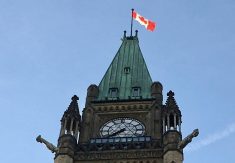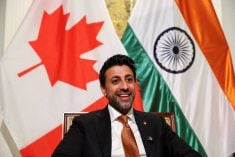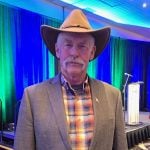Five Alberta Conservative MPs will appear before a House of Commons committee on Tuesday to complain about proposed changes to their riding boundaries.
The appearance of the five MPs, including junior finance minister Ted Menzies and newly elected Calgary MP Joan Crockatt, will attract little attention.
MPs from all parties in other provinces have intervened to argue against electoral boundary changes that affect them, the result of population shifts revealed in the 2011 census.
However, when Saskatchewan Conservatives troop before the same procedure and House affairs committee late this month or in March, Parliament Hill will be atwitter.
Read Also

U.S. corn and soybean yields revised down by USDA
Soybean and corn yields in the United States were revised downward from earlier estimates in updated supply/demand tables from the United States Department of Agriculture released Nov. 14.
They will argue that an electoral commission report, opposed by commission member and Saskatchewan Association of Rural Municipalities president David Marit, is wrong because it proposes five urban Saskatchewan ridings rather than the rural-urban mix that now exists in eight of the province’s 14 seats.
They will argue that the majority of Saskatchewan residents who responded to the proposal opposed it and it would divide rural and urban Saskatchewan.
The Conservative party has paid for telephone calls to Saskatchewan residents suggesting the electoral commission proposals are misplaced.
Opposition MPs argue that Conservative MPs and the Conservative party are interfering in an independent electoral boundary redesign process that happens after every census.
Based on 2011 voting results, the new electoral boundaries would have resulted in at least two New Democrats being elected in an overwhelmingly Conservative province. The previous electoral map allowed Conservative rural votes to counteract urban votes, and the NDP has not won a Saskatchewan seat since 2000.
In the House of Commons Feb. 6, opposition MPs accused the Conservatives of trying to subvert the electoral boundary redrawing process for partisan reasons in Saskatchewan.
Prime minister Stephen Harper rejected the accusation.
“Those (electoral boundaries) commissions accept and expect input from parliamentarians, from political parties and from the general public,” he told NDP leader Thomas Mulcair. “In Saskatchewan, there has been overwhelming opposition to the particular proposals but we are simply operating within the process that exists.”
Agriculture minister Gerry Ritz, political minister for Saskatchewan, made the same point while rejecting opposition accusations that the Conservatives were “interfering” with the independent boundary commission.
“The process allows and encourages the public to make submissions (and) at the end of the day, the commission will make the decision,” he said in the Commons. “Seventy-five percent of the submissions they received during the initial process were in favour of boundaries remaining the way they were. We stand with Saskatchewan residents in asking that the commission re-evaluate the work it did and re-establish the boundaries as they have been.”
In his dissenting report, Marit recommended MPs reject the report and send it back to the divided commission for a compromise.
The majority on the government appointed commission — justice Ronald Mills and University of Saskatchewan political scientist John Courtney — argued that the changing demographics and growing urbanization of the province require a break from the rural-urban formula of the past and creation of three Saskatoon and two Regina ridings that are strictly urban.
They argued that the traditional rural-urban riding mix is a relic of a past age,
“Within cities, many who once lived on farms or in small towns or villages no longer have any connection to rural or agricultural life,” they wrote. “Residents who move from other parts of the country or the world have little understanding of Saskatchewan’s rural way of life.”














